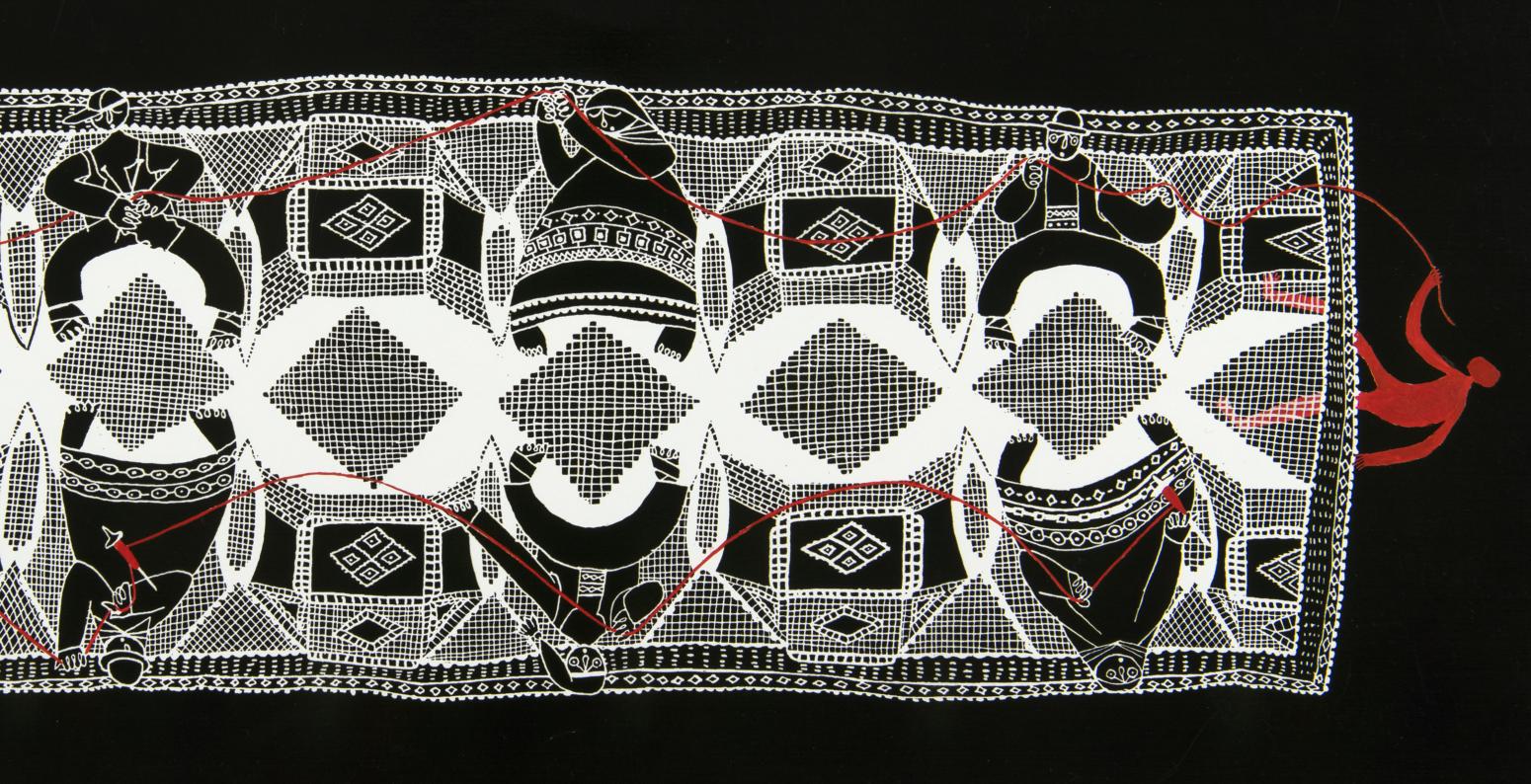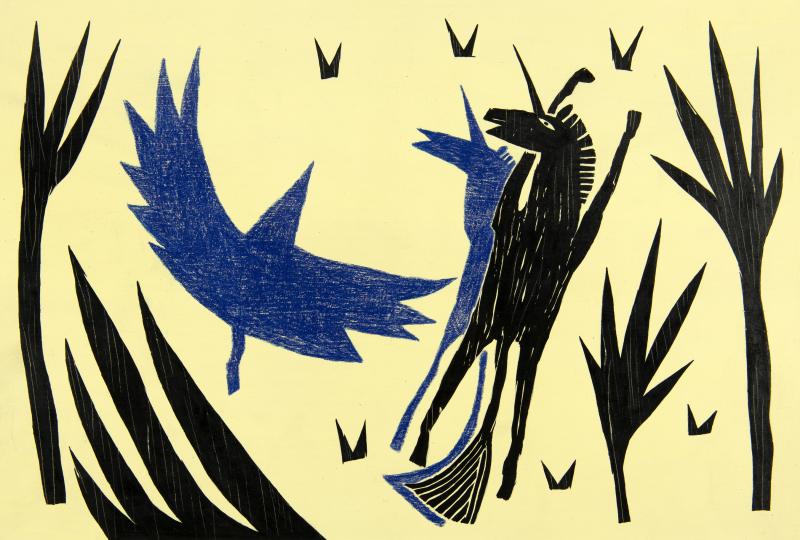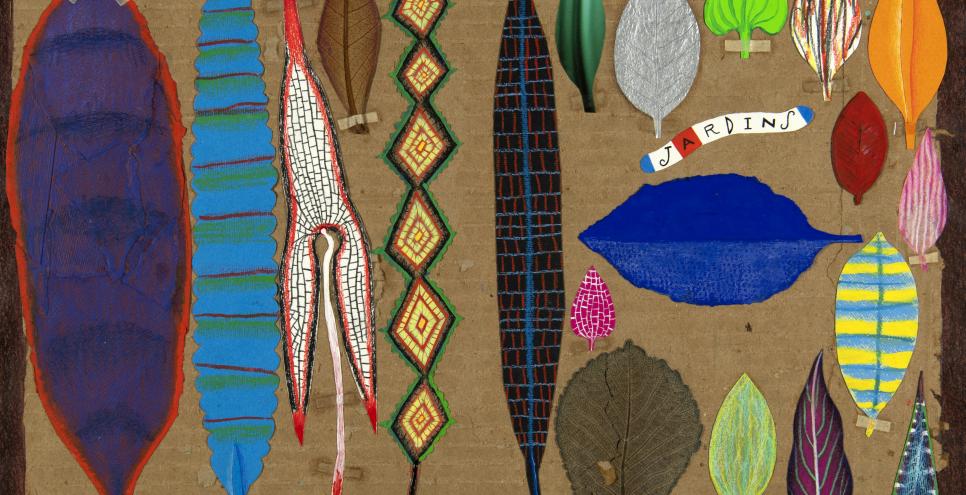
Roger Mello, Artwork for Joāo by a Thread (Elsewhere Editions). Collection of the artist. © 2006 Roger Mello.
Preparing the Soul to Do The Work: Presenting Roger Mello
Do you know someone who can simultaneously talk about poetry, politics, and the environment, all while cooking dinner for friends? Someone who can also name a myriad of insects and explain their behaviors? What about someone who also cares for 200 orchids?
Roger Mello is that someone. He is a world-renowned illustrator of over 100 books, author of thirty, a playwright, and more. In 2014, the International Board on Books for Young People (IBBY) recognized Mello with the Hans Christian Andersen Illustrator Award, honoring a lifetime of enormous contributions to the world of books for children. Roger Mello is the epitome of what it means to be a Renaissance Man. Telling the story of who he is requires the ultimate range of colors available in the world. The interesting thing is that just when we think we know who he is, he turns slightly, or the lights shift, and then we see another side we hadn’t even anticipated, and each projection shows the most amazing brilliance.
Mello breathes inventiveness and imagination as he expresses stories in visual treats that invite his audiences along to join in on his journey. He views creating books for children as more than a job: it is an act of soul-sharing. Brazilian illustrator Ziraldo said of Mello, “Although his hands are powerful and competent instruments, the soul must be prepared if the hands are to perform properly.” In Mello’s case, he creates from within, both what he knows and what he wants to know, imaginatively and inventively expressed from his lived life. To truly know Roger Mello’s work, we must first be introduced to the person behind the creations, for his artwork emanates from the essence of who he is.
Inciting Curiosity: Book Beginnings
Mello grew up during the time of dictatorship and military rule in Brazil, a time when the government controlled the flow of ideas and philosophy through banning books. Therefore, he concluded that books and thinking were powerful, as they could get people in trouble. How, then, could he capture such power? Throughout his childhood and youth, he immersed himself in the riches that books offered. These days, Mello is one who creates power through picture books. He never moralizes to children; he believes that as the textual and visual creator of children’s books, he should not provide or even suggest answers, and certainly not allude to a single solution. Rather, he proposes questioning together with the readers and thereby showing his respect for children’s ability to think and question, to consider possibilities, and ponder the world.
You Can’t Be Too Careful (1999) playfully considers what might happen if an event precipitates a chain of reactions and chaos ensues. In a thought-provoking cumulative cause-and-effect style, characters and their relationships change. Considering the consequences of kindness as opposed to the effect of greed, child readers are left with enough gaps to fill with their imaginations as they contribute to their understanding of the story. The hand-lettered text adds to the playful intrigue of how the story is told.

Roger Mello, Artwork for Charcoal Boys (Elsewhere Editions). Collection of the artist. © 2009 Roger Mello.

Roger Mello, Artwork for Charcoal Boys (Elsewhere Editions). Collection of the artist. © 2009 Roger Mello.
Charcoal Boys (2009) has a wasp as the main narrator, who follows two boys around as they live and work in a charcoal mine. The wasp describes what is seen and wonders why things happen as they do. Hanging upside down and building his own house of clay, the wasp compares his to the clay ovens in which the charcoal burning occurs. Turning the book into an art object, Mello conveys the heat of the fires the boys must endure by layering brilliantly florescent pages cut into flames. Since the wasp doesn’t know the concepts of child and child labor, he cannot impose judgment. Therefore, Charcoal Boys brilliantly addresses a pressing issue, but avoids socio-political didacticism through immersive storytelling.
The Theater of Life & the Theatre of the Page
In many ways, Mello lives in the theatre world. He observes it, he engages with it, and he creates it. His earlier plays for children continue to be performed both by and for children and have even been made into short films. Although primarily a playwright, he can attend to all the details associated with producing a play: in Mundo na Mao, Mello not only wrote the script, but acted and directed as well. He wrote some of the music and the lyrics for another musical, Maria Teresa, based on his book for children published in 1996.

Roger Mello, Artwork for Contradança (Companhia das Letrinhas). Collection of the artist. © 2011 Roger Mello.
Mello carries this philosophy into his inventive approach to book design. Unafraid to experiment, he jumps headfirst into a project, making sure that the medium matches the message. Of Contradança (2011), which he illustrated with stunning black-and-white photographs, he reflects:
“[In the book, a] little girl wants to be a ballerina, her father is a glazier and the house is full of mirrors. Her mother was a ballerina and probably died not too long ago. Everything is suggested, from the relationship of the girl with the figure of the mother, still present, to the imminence of the figure of the father, in silence, perhaps working in the other room. But the girl sees reflections and converses with a monkey, or rather, the reflection of a monkey. The contradance, the dialog, allows us to find things strange through of the other, not to understand in any definitive way, but as something to be followed up. In order to illustrate this book, I made a putty doll of the girl and sewed an organdy skirt for her. I had never sewed organdy before. I always change the styles of illustration when I write a book. In this case, I needed the doll in three dimensions, create the spaces and the monkey and then take photographs. The transposition of the three-dimensional into the two-dimensional, for photos in black and white, gave me a better understanding of the dimensions of the girl.”
Mello’s heart is consumed by music. He listens, hums, sings, and composes. He doesn’t take it for granted—like with all well-tuned skills, he practices vocalizations by watching video demonstrations and holding his fingers on his throat while emulating the sounds he is hearing. In other words, he knows it takes learning through practice to improve his skills. This full engagement with music can be seen in his illustration work—his characters move, dance, and express in rhythmic ways.

Roger Mello, Artwork for Joāo by a Thread (Elsewhere Editions). Collection of the artist. © 2006 Roger Mello.
For example, João by a Thread (2006) conveys a story through dream. The young protagonist sleeps under a handmade bedspread (inspired by traditional Brazilian embroidery) that has a network of story possibilities that become elements in his dreams. When the unraveling initially brings about rivers and mountains and he feels exposed and out of control, João sews up the words to cover himself under a quilt of his own story making.
From the front cover as the marquee advertising the story to the endpapers that draw us in and set the tone while offering foreshadowing of the story within; from the title page that acts as the playbill to prepare us for the show that is about to begin to the heart and soul of the storytelling, to the closing of the picture book that extends an invitation for readers to continue their own interpretations beyond the covers of the book.
Gathering Inspiration: Nature & Travel

Roger Mello holding a praying mantis. Image courtesy of Junko Yokota.

Roger Mello, Artwork for Espihno de arraia (Global editora). Collection of the artist. © 2022 Roger Mello.
Mello’s profound connection to and love of nature is evident in all aspects of his life. He is not a mere careful observer but studies nature in ways that show his deep curiosity. His fascination with the world of plants, insects, and animals extends to a deep love for the natural world. This inquisitiveness played out as a commitment to knowing extends into his beautifully aesthetic portrayals that go beyond the literal to a more artistic rendition. His hope is for child readers to go from his visual invitation to being drawn in, to wanting to know more for themselves, and to want to care for this natural world as he does.

Roger Mello, Artwork for Feather by Cao Wenxuan (Elsewhere Editions). Collection of the artist. © 2017 Roger Mello.
Feather is cooperative bookmaking between two winners of the IBBY Hans Christian Andersen award and tells the story of a feather in search of its owner. Floating through the air, the feather asks various birds a variation of the classic question, “Are you my mother?” Perhaps the question is classic and the story theme well known, but the interpretation given by author Cao Wenxuan and illustrator Roger Mello shows creative energy and beauty. The book comes together in its complete book design—the long, horizontal format that emphasizes the journey of the feather is made more complex and specific to the story with a flap at the end that shows half a feather that remains constant and unmoving throughout the book reading. The other half of the feather is on the page that is turned, signaling at once, the continuity of the story as well as the journey of the feather.
Mello is the most intrepid world traveler, quite peripatetic in his lifestyle. Perhaps his work life has been the initial purpose of his travels but always, the travel is more than merely about his work. His wanderings take him all over the world, and wherever he goes, he explores with keen enthusiasm. He seeks to feel and know a place, to breathe and experience in ways that fully experience what he can during his time there. It is this full-hearted immersion that forms the foundation of how Mello lives in this world, and how that can be seen in his illustrations he produces. Viewers of his books will understand how this plays out for their viewing — seeing the immersive illustration style is to be fully engaged within the world he creates with an exploratory mindset.

Roger Mello, Artwork for Magma Boy by Woo-hyon Kang (Namibooks). Collection of the artist. © 2017 Roger Mello.
Magma Boy (2017) is co-created with Woo-hyon Kang and published by Nami Books. The idea was born when the two artists imagined how the Korean volcanic island of Jeju came to be. Mello and Kang do not speak the same languages; Mello speaks Portuguese, Spanish, and English; while Woo-hyon speaks Korean and Japanese. But through gestures and intonations and animated sound-effect filled storytelling, the two created a storyline that Mello drafted for the book. The two brought together the natural elements of the island: a child of the volcano and a mermaid of the ocean; they included the Haenyeo women divers into the storytelling. Their illustration styles are completely the opposite: Kang makes fast brush strokes on a large scale, and Mello makes intricate, detailed drawings on an intimate scale. Yet through their mutual respect of one another and negotiating their differing styles, the storyline developed into a seamless whole, and the artwork negotiated the balance of the work that they created together into unified whole.
Books as Objects of Art and Thought
While it is true that much of Mello’s work has elements that can be identifiable as “Roger Mello style”—there is as much variance in his work as there are similarities. His love of strong colors has led to his use of color-saturated wall paint in addition to felt-tip markers, color pencils, collage materials, and more.
Griso, the One and Only (forthcoming 2024) is Mello’s newest book to be published in the United States. In this story, a unicorn is in search of another. As the pages are turned, the illustration styles adapt to different historical styles of art. While adults worry that children may be confused by this constant shifting, Mello found that they are not. Instead of focusing on such surface shifts, they are concerned with the inner journey and experiences of the unicorn, such as why the unicorn was all alone and unable to attract anyone’s attention.
As a visual storyteller, Mello’s work has infinite nuances. He often references historical artifacts or cultural elements but interprets them through his own aesthetics. As a verbal storyteller, Mello’s care in shaping the story and his close attention to the details of individual word choices come together to encompass a musical rhythm. Together, the culmination is both meticulous and evocative, and at once, thought-provoking as well as aesthetically engaging.
Sharing in and with the World

Roger Mello at the IBBY Hans Christian Andersen Award Ceremony. Image courtesy of Junko Yokota.
Mello’s generosity can be seen everywhere, but in the children’s book world we see him volunteering, mentoring, and generously giving. His numerous awards, accolades, and extensive international exhibition history serve as a jumping off point to participate in all aspects of the children’s literature community. Mello’s participation in the international community includes serving as a critic, jury member, and jury president. He often judges the work of other illustrators based on his own experiences in understanding what ideas have potential and can be developed into books. In this capacity, Mello models listening, engagement, and soliciting the opinions of others as the group works to make collective decisions. Rather than just judging competitions, Mello offers illustrators critique, mentorship, and enduring support.
He has also worked with organizations to create commissions that support their charitable missions, such as his 2020 design for the Scarves for IBBY innitiative. Mello and Volnei Canônica are the president and the vice-president of Quindim Reading Institute, a non-profit literacy promotion center in the South of Brazil, which features an International Library of more than 7000 books, with free access for children of all ages.
One cannot separate this creator from his creation because his lived experiences and his attitudes on life are intertwined in a way that impacts his creative process. To know the work of Roger Mello is to know a kind, caring, intelligent artist who offers an invitation to think, play, and to ponder the world. We can see playful commotion—the fuzuê—in the works of Roger Mello because he lives his life filled with playful explorations. Here’s to continued playful commotion inspired by the imaginative and inventive work of Roger Mello, and continued in the lives of those who are fortunate enough to experience his artwork. What kinds of futures await because of these experiences we have been offered?
Awards
Mello is highly regarded in his home country of Brazil. He has been awarded the Jabuti Award ten times by the Brazilian Chamber of Books. The Brazilian Academy of Letters and the Brazilian Union of Writers have both recognized him for the entire body of his works. For his multiple awards he is considered hors concours by the National Children’s and Young People’s Book Foundation (FNLIJ), the Brazilian Section of IBBY.
Mello’s work has garnered international accolades. His book Meninos do Mangue received the international award for best book of the year from the Fondation Espace Enfants (Switzerland). In November 2014, in the city of Shanghai, he received the Chen Bochui International Children’s Literature Award as the best foreign author in China. The book written by Cao Wenxuan and illustrated by Roger Mello received the award Most Beautiful Book in China. His book Enheduanna illustrated by Mariana Massarani won the “best foreign work” award at the Chen Bochui International Children’s Literature Prize (Cicla) in 2019.
In the United States, Mello’s books have been honored with the Batchelder Award as well as being listed for the USBBY (United States Board on Books for Young People) Outstanding Books for Children. You Can’t Be Too Careful!, a version of his books Todo Cuidado é Pouco! and João by a Thread, translated by Daniel Hahn, were included among the seven best books of 2017 by Kirkus Reviews, United States by the Mildred L. Batchelder Honor Books List (ALA, American Library Association). Griso, el Único, translated into Spanish, was included by Fundación Cuatrogatos (Miami, USA) among the 20 best books in the Spanish language in the United States in 2017. Mello was a finalist for the Kirkus Prize in 2023 in the United States.
Exhibitions and Fairs
His participation as an artist in the international community of illustrators has been far-reaching. From individual works in group exhibitions ranging in locales from Spain, Italy, Germany, and Sweden (to name a few) to a focused exhibition of his work at the International Youth Library in Munich, Germany, to a large-scale solo exhibition at Seoul Art Center in Seoul, Korea, Roger has exhibited in the international world of illustration for children.
Mello has taken part in several international book fairs, including those in Catalonia, Rome, Frankfurt, Bologna, Gothenburg, Sarmede (Le Immagini Della Fantasia), New Dehli, Padova (I Colori del Sacro), Nami Island (South Korea), Bogotá, Santo Domingo, Havana, Stellenbosch, and Teheran. The INTERNATIONALE Jugendbibliothek organized his solo exhibition, fantastische FarbenReich des brasilianischen illustrators ROGER MELLO, from 30 November 2011 to February 2012 in Blutenburg Castle, Munich, Germany. It travelled in 2013 to the German cities of Cologne and Wetzlar, and Chihiro Art Museum Azumino (Japan). Mello had a solo exhibition at the 2015 Bologna Book Fair, and was featured in the Hans Christian Andersen Award 50th Anniversary Exhibition, which travelled through Taipei, Beijing, and throughout Chinese capitals.













